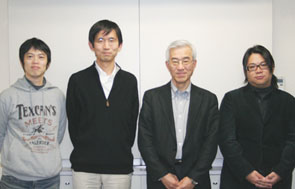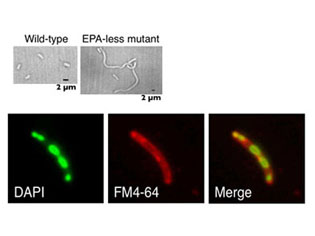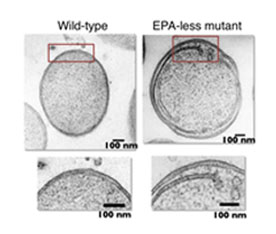Associate Professor KURIHARA, Tatsuo; Dr. KAWAMOTO, Jun; Assistant Professor MIHARA, Hisaaki and Professor ESAKI, Nobuyoshi, “Physiological role of a long-chain polyunsaturated fatty acid, eicosapentaenoic acid” (Published in Jan 2009)
|
Associate Professor KURIHARA, Tatsuo , Dr. KAWAMOTO, Jun , Assistant Professor MIHARA, Hisaaki and Professor ESAKI, Nobuyoshi (Laboratory of Molecular Microbial Science, Division of Environmental Chemistry)
“Physiological role of a long-chain |
 Assist Prof Mihara H, Assoc Prof Kurihara T, Prof Esaki N, Dr Kawamoto J (from left side) |
 Figure 1. Lack of EPA caused a defect in cell division. DNA and membrane were stained with DAPI and FM4-64, respectively. |
Long-chain polyunsaturated fatty acids (PUFAs), such as eicosapentaenoic acid (EPA) and docosahexaenoic acid (DHA), are attracting a great deal of attention mainly because they have beneficial effects on human health. Intake of adequate amount of fish containing PUFAs is generally recommended, and various supplements containing PUFAs are commercially available. PUFAs occur in organisms as the acyl group of phospholipids in membranes. They play important roles not only in animals but also in microorganisms. Assoc. Prof. Kurihara, Dr. Kawamoto (Assist. Prof. , Institute of Sustainability Science, Kyoto Univ.), Assist. Prof. Mihara, Prof. Esaki and their colleagues discovered new physiological functions of EPA by using a marine bacterium that produces EPA as an acyl component of membrane phospholipids. The bacterium was isolated from Antarctic seawater and grows well at low temperatures. Assoc. Prof. Kurihara et al. identified the genes coding for EPA biosynthesis enzymes and disrupted them to obtain EPA-less mutants. The lack of EPA did not affect the growth at 18˚C, which is a relatively high temperature for this bacterium. In contrast, the growth rate of the EPA-less mutants was significantly lower than that of the parent strain at 4˚C. Thus EPA is important for the growth of this bacterium at low temperatures. |
| Further studies revealed that the mutant has a defect in cell division (Fig. 1) and abnormal intracellular membranes occur in the mutant (Fig. 2). While PUFAs are often thought to increase the fluidity of the hydrophobic membrane core, diffusion of a small hydrophobic molecule, pyrene, in the cell membranes was not significantly different between the EPA-less mutant and the parent strain. The membrane fluidity of this bacterium is probably ensured by a large amount of unsaturated fatty acids, other than EPA, but not by a small amount of EPA (about 5% of the total fatty acids). They found that the amounts of several membrane proteins were affected by the depletion of EPA. They also found that the growth and morphological defects caused by the EPA depletion can be suppressed by overproduction of a certain membrane protein. These results imply that phospholipids containing EPA play a beneficial role in membrane organization and cell division at low temperatures possibly through specific interaction between EPA and proteins involved in these cellular processes. This research was carried out in collaboration with Assoc. Prof. Satoshi Sato, Research Center for Low Temperature and Material Sciences, Kyoto Univ. and Prof. Takeshi Baba, Ibaraki Prefectural Univ. of Health Sciences. A part of these results are published in Journal of Bacteriology (2009), p. 632-640, Vol. 191, No. 2. |
 Figure 2. Lack of EPA caused the development of intracellular membranes. |
 Institute for Chemical Research, Kyoto University
Institute for Chemical Research, Kyoto University International Joint Usage Research Center
International Joint Usage Research Center